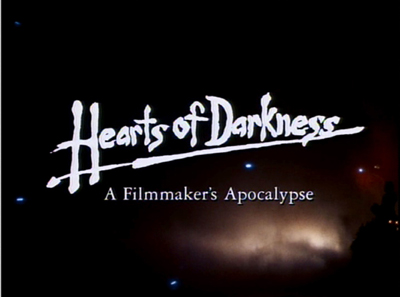
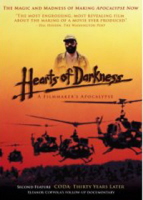 BUY IT FROM AMAZON: CLICK HERE!
BUY IT FROM AMAZON: CLICK HERE!
STUDIO: Paramount
MSRP: $24.99
RATING: R
RUNNING TIME: 96 minutes
SPECIAL FEATURES:
- Audio Commentary with Francis and Eleanor Coppola
- CODA: Thirty Years Later
The Pitch
“Anybody want to watch a car crash?”
The Humans
Francis Ford Coppola, Eleanor Coppola, Martin Sheen, Robert Duvall, Frederic Forrest, Sam Bottoms, and Larry Fishbourne.
The Nutshell
Francis Ford Coppola went to the Philippines to shoot Apocalypse Now. Since he didn’t want to be away from his family for so long, he brought them with him and put his wife, Eleanor, to work filming the behind-the-scenes promo. The shoot was to take sixteen weeks and the promo was to be five minutes. Sometimes things don’t go quite as planned.
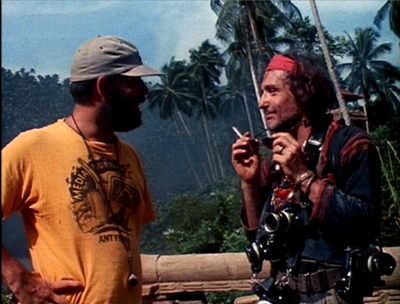
"Earth to Dennis. Dennis, come in."
The Lowdown
People call Hearts of Darkness the greatest making-of documentary ever. People are sometimes mistaken. Hearts of Darkness is a great film, but something’s off. I found myself distracted more than engrossed while watching it. Sometimes things that almost have nothing to do with the film can weigh it down. The making of Apocalypse Now has become such a fixture in filmmaking lore that watching the film is almost like working your way down a checklist. Storm destroys sets, check. Sheen has a heart attack, check. Brando is fat and doesn’t know what’s going on, check. The thing that distracted me most about Hearts of Darkness was how similar it is to the other great “visionary director goes to the jungle” documentary: Burden of Dreams, Les Blank’s film on the making of Werner Herzog’s Fitzcarraldo.
The two productions shared many similar problems: replacing actors, difficult actors, uncooperative weather, and real-life conflict. Instead of exploring the problems like Blank does, Eleanor Coppola merely captures them on film. Granted the filmmakers were seeking different aims with their films (Coppola a promotional piece and Blank an all-encompassing look) and had different levels of experience in documentary filmmaking, but when Coppola does turn her camera away from the production and to the surrounding happenings, it seems like the actions of a tourist, whereas Blank is more of an anthropologist. The best example of this is how they show the native extras’ customs. Masato is a ceremonial liquor used in Herzog’s film when Fitzcarraldo makes a pact with the Indians. Blank shows us how masato is made and explains the role it, and the yuca root it’s made from, plays in the native tribes. When the Ifagao Indians are brought into the Apocalypse Now shoot as extras, Coppola sees them performing a ceremony where a carabao meets the business end of a few machetes. Her reaction is basically “oh hey that’s neat. Hey Francis, come look at this.” We don’t learn anything about the ceremony or really anything about the Indians at all. The same goes for the rebellion that results in the hired helicopters leaving at a moment’s notice. These missed opportunities to expand the scope of what we’re seeing hurt the documentary.
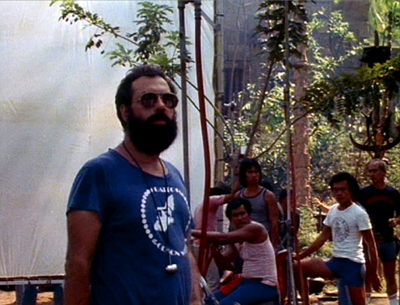
"Can I get a club soda?"
The other thing that really hurts Hearts of Darkness is Coppola himself. Not the Coppola we see in the documentary, but the present-day Francis Ford Coppola. He goes on and on about how embarrassed he is with the way he comes across in the documentary, so you expect him to be this complete lunatic, but he’s just a man under an extraordinary amount of pressure. He has everything riding on his film: his financial well-being, his artistic reputation, his health. He has no idea how the film is going to end. There are a million ways the film could fall apart, so when something does pop up, of course Coppola is going to try to do everything he can to save the film. Even say that Martin Sheen isn’t dead unless he says he’s dead. There’s not really anything Coppola can do to help Sheen, so he has to focus all his energy in keeping the film alive. Coppola’s reaction to the documentary is like the contestant on Big Brother crying about the photo of herself. You’re a big boy Francis, it doesn’t matter what other people think about you. Herzog doesn’t make a huge fuss about how he comes across in Burden of Dreams (just a little one). Sometimes you have to be able to laugh at yourself.
All disappointment aside, Hearts of Darkness is still a great documentary, just not the greatest. There’s no way to comprehend how totally insane the production of Apocalypse Now was just by hearing the stories; pictures being worth a million words and all. It shows Coppola overcoming insurmountable odds to create one of the greatest films ever (though he didn’t quite lick the ending). If only he wasn’t such a crybaby.
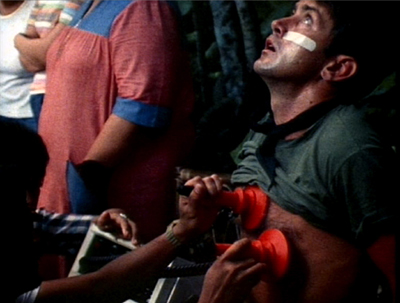
"God, are you there? It’s me. Marty."
The Package
Hearts of Darkness wasn’t included in the “Complete Dossier” edition of Apocalypse Now because of crybaby Francis. His feelings about the film haven’t changed, so why are we finally seeing it on DVD? Well you see, he’s got a new film coming out that needs promoting, Youth Without Youth.
Coda: Thirty Years Later shows us Coppola shooting another film in another foreign country (wintry Romania). But this is not the same Coppola. No, this is a kinder, gentler Francis Coppola. We’re shown this right off the bat when Eleanor speaks about her husband’s new project and he lurks into frame behind her, pantomiming and clowning around. The majority of the documentary is spent showing how great Coppola is with actors and how reinvigorating it is to be working on a small budget with a small crew. He pontificates at length on the themes of the new film, usually while laying in bed. He wears the same pink shirt that he does in the special features on the new Bram Stoker’s Dracula DVD. The documentary is pretty fluffy, but has its merits. We see some of the second unit footage of the aborted Megalopolis project. Clips from the George Lucas-helmed Making of The Rain People pop up here and there. Some home movies with the young Coppola make an appearance. There’s also some footage of Coppola’s very first short, No Cigar. It shows the routine of a lonely man after a day at work. It’s interesting because of how the man is the prototype for many of Coppola’s protagonists. The documentary highlights the similarity between the man in No Cigar and Harry Caul in The Conversation. But the image of the solitary man, alone with his thoughts, occurs in many of Coppola’s films (Michael in The Godfather films; Curtiz in Apocalypse). Coda rights itself after the brief look back and returns to the pontificating, actorly concerns, and Coppola reborn.

"I spy with my little eye."
The commentary is Francis’ opportunity to finally set the record straight concering Hearts of Darkness. But since he’s done that every chance the words heart, of, or darkness have been uttered, his comments are pretty useless. Eleanor keeps mostly to what it was like on set, her impressions of the cast and crew, and other anecdotal tidbits. She balances Francis out and redeems the commentary, making it worth at least listening to in the background.
While it’s nice to finally see Hearts of Darkness on DVD, a little more tender love and care would have gone a long way. I wouldn’t be surprised to see Jack get a better DVD. It’s not like there isn’t anything that could be added. I’m sure there’s some extra footage that could be tossed on. Where’s the footage with Harvey Keitel? Okay, maybe that would still be MIA (as George Hickenlooper explains in this interview). Hickenlooper and Fax Bahr could have been interviewed or recorded a commentary. This is a shining example of being dumped onto DVD.